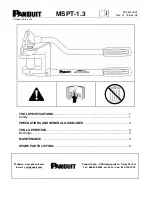
39
General Sharpening Procedures
Having the blade and lever cap in position and
tightened introduces the permanent forces that the
plane will experience. With these forces in place as
the sole is being trued, you have some assurance
that the sole will be flat when you really need it to
be flat, that is, in use.
3.
True the bed:
The bed is everything that the blade
rests on, including the frog and the machined surface
adjacent to the mouth. The machined surfaces of the
bed should be in a single plane from top to bottom
and side to side. This may require some adjustment
of the frog (if it is adjustable) or filing of the bed, with
frequent test fittings of the blade using machinist’s
dye or carbon paper to indicate high spots.
This is exactly the same process that dentists use to
test and then modify a new filling to suit your bite.
With a plane, if you paint the blade with machinist’s
dye, the dye will transfer to the high points of the
bed when the blade is pressed into position. If you
use carbon paper, put the carbon side next to the
bed before positioning the blade.
4.
Dress the lever cap:
The first
1
/
8
in. or so of the
lever-cap bottom should be lapped on a stone so
that it will create a single line of contact with the
cap iron, or with the blade itself on those models
that do not have a cap iron. This is important since
the lever cap has to fit well to tension the blade in
the plane, minimizing chatter in use.
Lapping the Sole
When the sole of a plane body is being milled (or ground),
the plane is clamped on the cheeks. The clamping pressure
causes the sole to arch outward. When the clamps are
released after machining, the finished sole is almost
invariably hollow. A bit of hollowness is of no great concern,
but there are three places where you must be certain that
the sole is dead flat after lapping — both tips and the front
of the mouth, as shown below.
Moving the plane in a figure-eight or circular motion, lap the
sole with silicon-carbide grit on a sheet Mylar-faced plate glass.
Use a straightedge to check that the machined surfaces of
the frog are true. Check diagonally as well as transversely.
(Photo by Susan Kahn)
Dress the tip of the cap iron on a stone, with the opposite end
of the iron held about
1
/
8
in. below the level of the stone.
The dressed cap iron should fit tightly across the width of
the plane blade.
Hollow sole from
grinding process
Summary of Contents for Mk.II
Page 6: ...vi Veritas Mk II Power Sharpening System ...
Page 14: ...8 Veritas Mk II Power Sharpening System ...
Page 20: ...14 Veritas Mk II Power Sharpening System ...
Page 33: ...27 Exploded Assemblies Master Parts List 5 3 13 9 7 2 14 24 21 1 6 22 20 19 18 17 16 15 23 4 ...
















































